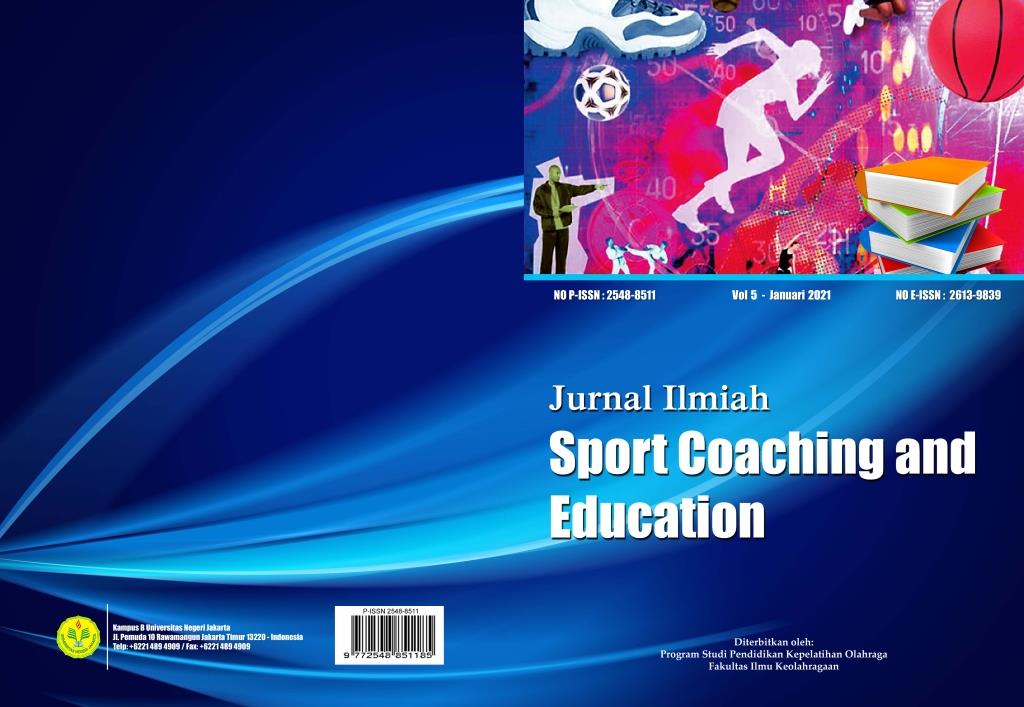Kondisi Fisik Olahraga Bulutangkis
DOI:
https://doi.org/10.21009/JSCE.05106Keywords:
Bulutangkis, Kondisi FisikAbstract
ABSTRACT
If an athlete wants to have a good physical condition, then the player or athlete must improve their physical condition so that an athlete is able and easy to perform a technique appropriately and well, and does not easily get tired when participating in training or competition, training can be passed by right, and something that is not desired or even constrained, can be resolved by having an athlete's desire to learn, and following the training appropriately and correctly Physical condition is very necessary, for a student or athlete because if the physical condition is less automatic, the desire to become a champion will experience various difficulties and it is impossible to achieve high achievement. The physical condition status for a badminton or badminton player will be able to provide a point or value to achieve the target or target in order to enter the national plate according to the criteria determined by the national plate. The training conditions for badminton can be interpreted as the ability of individual athletes who will take a player or athlete to a higher level and can measure the extent to which an athlete is capable. As well as good athletes must master the various components to support achievement. One of the ways to determine the physical condition of an athlete is influenced by the appropriate pattern of recovery. Not only that, the coach is also an indispensable support for an athlete in order to increase the performance of an athlete. A professional trainer has competence in his / her field of expertise.
Keywords: physical condition, badminton, sports, body components.
References
Akhsan, (2012: 52). Faktor risiko yang memengaruhi keterlambatan konsepsi (infertlitas) pasangan suami istri pada laki-laki di kecamatan palu utara kota palu. JST Kesehatan.
Basri Yusuf, (2014: 8-9). Kriteria dan Parameter Fisik Atlet Masuk Pelatnas dan Atlet Pelatnas. Jakarta.
Bompa, (2003:45): Teori dan Metodologi Pelatihan. Dubugue, Iowa: Kendall – Hunt Publishing Company.
Harsono, (1988). Coaching Dan Aspek-Aspek Psikologis dalam Coaching. Jakarta: CV Tambak Kusuma.
Harsono, (2000:132). Pembinaan Olahraga Usia Dini. Jakarta. Pusat Ilmu Olahraga, KONI Pusat.
Heang, (2006). Pengaruh Pelatihan Plyometric terhadap Agility Siswa Mendaftar Program Bulu Tangkis Perguruan Tinggi yang Diperlukan. Jurnal Internasional Ilmu Olahraga Terapan.
Meylan & Malatesta, (2009). Pengaruh dalam - latihan plyometric musim dalam sepak bola berlatih aksi ledakan pemain muda. J Kekuatan Cond Res, 23, 2605 - 2613.
M Sajoto, (1995: 7). Pembinaan kondisi fisik dalam olahraga. Jakarta: departemen pendidikan dan kebudayaan direktorat jenderal pendidikan tinggi proyek pengembangan lembaga pendidikan tenaga kependidikan.
Poole, James. (2008). Belajar Bulutangkis. Sulistio Bandung: Pionir Jaya.
Russell, (1993: 11-12). Dasar-Dasar Ilmu Kepelatihan (terj. Kasiyo Dwijowinoto). Semarang: IKIP Semarang Press.
Sapta kunta purnama, (2010:52). Kepelatihan Bulutangkis Modern. Cetakan Pertama. Surakarta: Yuma Pustaka. Sireger, (2011:20). Mengenal Sebab-Sebab, dan Akibat-Akibat, dan Cara Terapi Indomnia. Jogjakarta: Buku Kita.
Subarjah, (2000: 13). Bulu tangkis jakarta: departeman pendidikan dan kebudayaan.
Subardjah (2000:27). Bulutangkis. Solo: CV Seti Aji.
Tony grice (1996:1). Bulutangkis Petunjuk Praktis Untuk Pemula dan Lanjut. Jakarta: Raja Grafindo Persada.
Usman, (2010: 41). Kejar Bulutangkis. Jakarta: Rineka Cipta.
Vaczi, et Al, (2011). Mekanis, biomekanik, dan EMG menanggapi pelatihan ekstensor lutut konsentris eksentrik jangka pendek pada manusia. J Kekuatan Cond Res, 25, 922-932.



